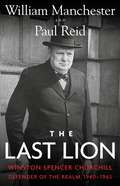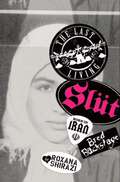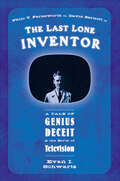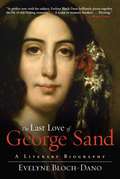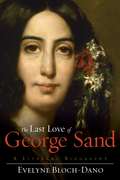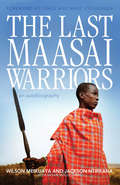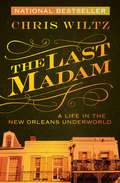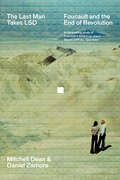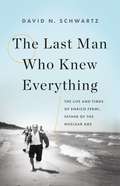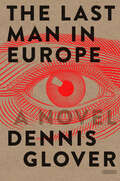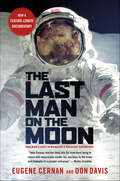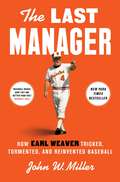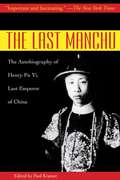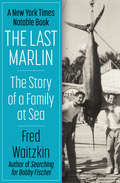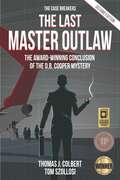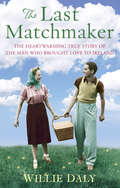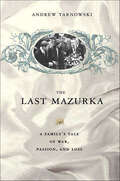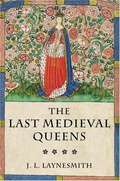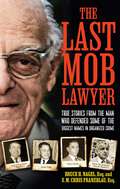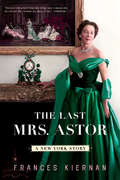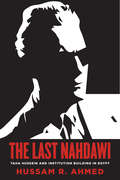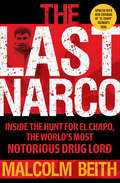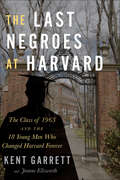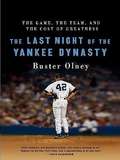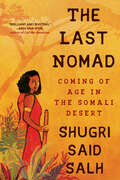- Table View
- List View
The Last Lion: Winston Spencer Churchill: Defender of the Realm, 1940-1965 (The\last Lion Ser. #3)
by William Manchester Paul ReidSpanning the years of 1940-1965, THE LAST LION picks up shortly after Winston Churchill became Prime Minister-when his tiny island nation stood alone against the overwhelming might of Nazi Germany. The Churchill conjured up by William Manchester and Paul Reid is a man of indomitable courage, lightning fast intellect, and an irresistible will to action. THE LAST LION brilliantly recounts how Churchill organized his nation's military response and defense; compelled FDR into supporting America's beleaguered cousins, and personified the "never surrender" ethos that helped the Allies win the war, while at the same time adapting himself and his country to the inevitable shift of world power from the British Empire to the United States. More than twenty years in the making, THE LAST LION presents a revelatory and unparalleled portrait of this brilliant, flawed, and dynamic leader. This is popular history at its most stirring.
The Last Living Slut: Born in Iran, Bred Backstage
by Roxana ShiraziThe Last Living Slut is the salaciously literary and sexually liberated memoir about Roxana Shirazi’s evolution from traditional Iranian to rock groupie.“Makes Pamela Des Barres’ I’m With the Band read like a nun’s diary in comparison. . . . The most gripping real-life account of female depravity we’ve ever read.” —New York Times–bestselling authors Neil Strauss and Anthony Bozza, from their IntroductionBorn in Tehran and raised within the strictures of Muslim religious culture, Roxana Shirazi’s life changed when her family immigrated to London, fleeing the Iranian Revolution. Thrust into an uptight environment where she was racially bullied, she found refuge in the sounds of hard rock and heavy metal, becoming obsessed with living the sex, drugs, and rock ‘n’ roll lifestyle that the music celebrated. When not pursuing her Masters degree in English, Roxana was attending rock concerts, pursuing her favorite musicians and exploring her voracious sexuality. Partying with members of Guns N' Roses, Mötley Crüe, Velvet Revolver, and other bands past their 80s hair metal prime, she pushed herself and her rock star conquests to sexual extremes.“Raw and real” (Orlando Sentinel), The Last Living Slut is a passionate tale of jilted love, brutal revenge, and backstage encounters from a woman who rocked harder than most metalheads—and their guitar slinging heroes—would have ever dared.
The Last Lone Inventor: A Tale of Genius, Deceit, and the Birth of Television
by Evan I. Schwartz“…Fascinating… A riveting American classic of independent brilliance versus corporate arrogance. I found it more fun than fiction.” — James Bradley, author of Flags of Our Fathers“… The fascinating inside story of how this eccentric loner invented television and fought corporate America.” — Walter Isaacson, chariman, CNN“…Compelling…Strong, dramatic prose…” — Kirkus Reviews“…A lively and engaging account.” — Library Journal“[A] gripping and eminently readable saga of the birth of television and the death of the Edisonian myth.” — Darwin magazine
The Last Love of George Sand: A Literary Biography
by Evelyne Bloch-DanoGeorge Sand is one the most celebrated writers and controversial personalities of nineteenth-century France; she is as famous for her bohemian lifestyle as for her written work. The Last Love of George Sand portrays the writer, political activist, and cultural figure as she starts a new chapter in her ever-surprising life: the mature years with her last lover, the young and talented engraver Alexandre Manceau. A turning point came for George Sand in 1849. After her political involvement in the revolution of 1848, Sand retreated to her country property, Nohant, with her son Maurice and started writing new plays. One day, Maurice introduced her to Alexandre Manceau, a young and shy artist thirteen years her junior. At forty-five, she was at the pinnacle of her career. She had a long history of tumultuous love affairs with famous artists such as Musset, Chopin, and Mérimée, but she had never experienced a peaceful and balanced relationship. With Manceau, Sand discovered that she could be loved, and fall in love herself, without drama. Their relationship would last fifteen years, and prove to be the most prolific period of Sand's life, with fifty books published including the novels Elle et lui, inspired by her relationship with Musset, and Le dernier amour, written just ten days after Manceau died of tuberculosis. Although much has been written about George Sand, most of the previous biographies are focused on her more turbulent times. In The Last Love of George Sand, Evelyne Bloch-Dano looks back on Sand's life from the vantage point of her years with Manceau.
The Last Love of George Sand: A Literary Biography
by Evelyne Bloch-DanoGeorge Sand is one the most celebrated writers and controversial personalities of nineteenth-century France; she is as famous for her bohemian lifestyle as for her written work. The Last Love of George Sand portrays the writer, political activist, and cultural figure as she starts a new chapter in her ever-surprising life: the mature years with her last lover, the young and talented engraver Alexandre Manceau.A turning point came for George Sand in 1849. After her political involvement in the revolution of 1848, Sand retreated to her country property, Nohant, with her son Maurice and started writing new plays. One day, Maurice introduced her to Alexandre Manceau, a young and shy artist thirteen years her junior. At forty-five, she was at the pinnacle of her career. She had a long history of tumultuous love affairs with famous artists such as Musset, Chopin, and Mérimée, but she had never experienced a peaceful and balanced relationship. With Manceau, Sand discovered that she could be loved, and fall in love herself, without drama. Their relationship would last fifteen years, and prove to be the most prolific period of Sand's life, with fifty books published including the novels Elle et lui, inspired by her relationship with Musset, and Le dernier amour, written just ten days after Manceau died of tuberculosis.Although much has been written about George Sand, most of the previous biographies are focused on her more turbulent times. In The Last Love of George Sand, Evelyne Bloch-Dano looks back on Sand's life from the vantage point of her years with Manceau.
The Last Maasai Warriors
by Susan Mcclelland Jackson Ntirkana Wilson MeikuayaHow two young Maasai tribesmen became warriors, scholars, and leaders in their community and to the world.They are living testament to a vanishing way of life on the African savannah. Wilson and Jackson are two brave warriors of the Maasai, an intensely proud culture built on countless generations steeped in the mystique of tradition, legend and prophecy. They represent the final generation to literally fight for their way of life, coming of age by proving their bravery in the slaying of a lion. They are the last of the great warriors.Yet, as the first generation to fully embrace the modern ways and teachings of Western civilization, the two warriors have adapted -- at times seamlessly, at times with unimaginable difficulty -- in order to help their people. They strive to preserve a disappearing culture, protecting the sanctity of their elders while paving the way for future generations.At this watershed moment in their history, the warriors carry the weight of their forbearers while embracing contemporary culture and technology. While their struggle to achieve this balance unfolds exquisitely in this story, their discoveries resonate well beyond the Maasai Mara.
The Last Madam: A Life in the New Orleans Underworld
by Chris WiltzThe &“raunchy, hilarious, and thrilling&” true story of the incomparable Norma Wallace, proprietor of a notorious 1920s New Orleans brothel (NPR). Norma Wallace grew up fast. In 1916, at fifteen years old, she went to work as a streetwalker in New Orleans&’ French Quarter. By the 1920s, she was a &“landlady&”—or, more precisely, the madam of what became one of the city&’s most lavish brothels. It was frequented by politicians, movie stars, gangsters, and even the notoriously corrupt police force. But Wallace acquired more than just repeat customers. There were friends, lovers . . . and also enemies. Wallace&’s romantic interests ran the gamut from a bootlegger who shot her during a fight to a famed bandleader to the boy next door, thirty-nine years her junior, who became her fifth husband. She knew all of the Crescent City&’s dirty little secrets, and used them to protect her own interests—she never got so much as a traffic ticket, until the early 1960s, when District Attorney Jim Garrison decided to clean up vice and corruption. After a jail stay, Wallace went legitimate as successfully as she had gone criminal, with a lucrative restaurant business—but it was love that would undo her in the end. The Last Madam combines original research with Wallace&’s personal memoirs, bringing to life an era in New Orleans history rife with charm and decadence, resurrecting &“a secret world, like those uncovered by Luc Sante and James Ellroy&” (Publishers Weekly). It reveals the colorful, unforgettable woman who reigned as an underworld queen and &“capture[s] perfectly the essential, earthy complexity of the most fascinating city on this continent&” (Robert Olen Butler).
The Last Man Takes LSD: Foucault and the End of Revolution
by Mitchell Dean Daniel ZamoraFoucault&’s personal and political experimentation, its ambiguous legacy, and the rise of neoliberal politicsPart intellectual history, part critical theory, The Last Man Takes LSD challenges the way we think about both Michel Foucault and modern progressive politics. One fateful day in May 1975, Foucault dropped acid in the southern California desert. In letters reproduced here, he described it as among the most important events of his life, one which would lead him to completely rework his History of Sexuality. That trip helped redirect Foucault&’s thought and contributed to a tectonic shift in the intellectual life of the era. He came to reinterpret the social movements of May &’68 and reposition himself politically in France, embracing anti-totalitarian currents and becoming a critic of the welfare state.Mitchell Dean and Daniel Zamora examine the full historical context of the turn in Foucault&’s thought, which included studies of the Iranian revolution and French socialist politics, through which he would come to appreciate the possibilities of autonomy offered by a new force on the French political scene that was neither of the left nor the right: neoliberalism.
The Last Man Who Knew Everything: The Life and Times of Enrico Fermi, Father of the Nuclear Age
by David N. SchwartzThe definitive biography of the brilliant, charismatic, and very human physicist and innovator Enrico FermiIn 1942, a team at the University of Chicago achieved what no one had before: a nuclear chain reaction. At the forefront of this breakthrough stood Enrico Fermi. Straddling the ages of classical physics and quantum mechanics, equally at ease with theory and experiment, Fermi truly was the last man who knew everything--at least about physics. But he was also a complex figure who was a part of both the Italian Fascist Party and the Manhattan Project, and a less-than-ideal father and husband who nevertheless remained one of history's greatest mentors. Based on new archival material and exclusive interviews, The Last Man Who Knew Everything lays bare the enigmatic life of a colossus of twentieth century physics.
The Last Man in Europe: A Novel
by Dennis GloverThis “riveting novel about Orwell’s last days” takes readers inside the renowned author’s mind as he creates his final dystopian masterpiece (New Statesman).April, 1947. In a run-down farmhouse on a remote Scottish island, George Orwell begins his last and greatest work, Nineteen Eighty-Four. Forty-three years old and suffering from the tuberculosis that within three winters will take his life, Orwell comes to see the book as his legacy—the culmination of a career spent fighting to preserve the freedoms which the wars and upheavals of the twentieth century have threatened. Completing the book is an urgent challenge, a race against death.In this masterful novel, Dennis Glover explores the creation of Orwell’s classic work which defined the twentieth century for millions of readers worldwide—and has continued to prove its unnerving relevance in the twenty-first. Simultaneously a captivating drama, a unique literary excavation, and an unflinching portrait of a writer, The Last Man in Europe will change the way we understand both our enduringly Orwellian times and Orwell’s timeless masterpiece.
The Last Man on the Moon: One Man's Part in Mankind's Greatest Adventure
by Don Davis Eugene CernanFrom the Apollo 17 commander and NASA veteran, “an exciting, insider’s take on what it was like to become one of the first humans in space” (Publishers Weekly).Eugene Cernan was a unique American who came of age as an astronaut during the most exciting and dangerous decade of space flight. His career spanned the entire Gemini and Apollo programs, from being the first person to spacewalk all the way around our world to the moment when he left man’s last footprint on the moon as commander of Apollo 17.Between those two historic events lay more adventures than an ordinary person could imagine as Cernan repeatedly put his life, his family, and everything he held dear on the altar of an obsessive desire. Written with New York Times–bestselling author Don Davis, The Last Man on the Moon is the astronaut story never before told—about the fear, love, and sacrifice demanded of the few who dare to reach beyond the heavens.“Thrilling highlights . . . a book not just about space flight but also about the often-brutal competition that went on between the US and the Soviet Union.” —Washington Times“A fascinating book.” —Charlotte Observer
The Last Manager: How Earl Weaver Tricked, Tormented, and Reinvented Baseball
by John W. Miller“Baseball books don’t get any better than this...Earl Weaver has at last been given his due.” —George F. Will. <br> “Vivid ... Most sports books are pop flies to the infield. Miller &’s is a screaming triple into the left field corner.” —Dwight Garner, The New York Times. <br> The first major biography of legendary Baltimore Orioles manager Earl Weaver—who has been described as “the Copernicus of baseball” and “the grandfather of the modern game”—The Last Manager is a wild, thrilling, and hilarious ride with baseball’s most underappreciated genius, and one of its greatest characters. <p> Long before the Moneyball Era, the Earl of Baltimore reigned over baseball. History’s feistiest and most colorful manager, Earl Weaver transformed the sport by collecting and analyzing data in visionary ways, ultimately winning more games than anybody else during his time running the Orioles from 1968 to 1982. When Weaver was hired by the Orioles, managers were still seen as coaches and inspirational leaders, more teachers of the game than strategists. Weaver invented new ways of building baseball teams, prioritizing on-base average, elite defense, and strike throwing. Weaver was the first manager to use a modern radar gun, and he pioneered the use of analytical data. By moving six-foot four-inch Cal Ripken Jr. to shortstop, Weaver paved the way for a generation of plus-sized superstar shortstops, such as Alex Rodriguez and Derek Jeter. He foreshadowed almost everything that Bill James, Billy Beane, Theo Epstein, and hundreds of other big-brain baseball types would later present as innovations. <p> Beyond being a great baseball mind, Weaver was a rare baseball character. Major League Baseball is show business, and Weaver understood how much of his job was entertainment. Weaver’s legendary outbursts offered players cathartic relief from their own frustration, signaled his concern for the team, and fired up fans. In his frequent arguments with umpires, he hammed it up for the crowds, faked heart attacks, ripped bases out of the ground, and pretended to toss umpires out of the game. Weaver also fought with his players, especially Jim Palmer, but that creative tension contributed to stunning success and a hilarious clubhouse. During his tenure as major-league manager, the Orioles won the American League pennant in 1969, 1970, 1971, and 1979, each time winning more than 100 games. <p> The Last Manager uncovers the story of Weaver’s St. Louis childhood with a mobster uncle, his years of minor-league heartbreak, and his unlikely road to becoming a big-league manager, while tracing the evolution of the game from the old-time baseball of cross-country trains and “desk contracts” to the modern era of free agency, video analysis, and powerful player agents. Weaver’s career is a critical juncture in baseball history. He was the only manager to hold a job during the five years leading up to and the five years after free agency upended the sport in 1976. <p> Weaver was inducted into the Baseball Hall of Fame in 1996. “No manager belongs there more,” wrote Tom Boswell. “Weaver encapsulates the fire, the humor, the brains, the childishness, the wisdom and the goofy fun of baseball.” The Last Manager tells the story of one man—belligerent, genius, infamous—who left his mark on the game for generations. <b>New York Times Bestseller</b>
The Last Manchu: The Autobiography of Henry Pu Yi, Last Emperor of China
by Paul Kramer Henry Pu YiIn 1908 at the age of two, Henry Pu Yi ascended to become the last emperor of the centuries-old Manchu dynasty. After revolutionaries forced Pu Yi to abdicate in 1911, the young emperor lived for thirteen years in Peking's Forbidden City, but with none of the power his birth afforded him. The remainder of Pu Yi's life was lived out in a topsy-turvy fashion: fleeing from a Chinese warlord, becoming head of a Japanese puppet state, being confined to a Russian prison in Siberia, and enduring taxing labor. The Last Manchu is a unique, enthralling record of China's most turbulent, dramatic years.
The Last Marlin: The Story of a Family at Sea
by Fred WaitzkinThe author of Searching for Bobby Fischer tackles his own childhood in this &“remarkably ambitious and satisfying memoir&” (The New York Times Book Review). Fred Waitzkin depicted the joys and trials of parenthood with remarkable perception in Searching for Bobby Fischer, the inspiration for the beloved major motion picture. A New York Times Notable Book, The Last Marlin is another sweeping family saga, the tale of an adolescence spent navigating between two very different parents and the discovery of a lifelong passion for deep-sea fishing. Waitzkin&’s father, Abe, is both a prolific salesman—the &“Beethoven of fluorescent lighting&” in the fifties—and a frail man, driven to succeed despite his declining health, while his mother, Stella, is an eccentric abstract artist, once a student of de Kooning and Hans Hoffman, and a free spirit who resents her husband&’s dirty business tactics and conventional notions of success. As their relationship disintegrates, Waitzkin is torn between them. But soon he finds solace on the ocean. At first, fishing is a way to bond with Abe—and irritate Stella—but over the years it becomes a way of life. From the Long Island Sound to the drug-infested coastline of Bimini and the marlin-rich waters of the Gulf Stream, Waitzkin comes to believe that fishing is the answer to all his problems, even as he starts his own family. Hailed by Outside magazine as &“a graceful father–son memoir that artfully braids rich, disparate strands,&” The Last Marlin is a tribute to the open sea, the solitude it provides, and the connections it fosters.
The Last Master Outlaw
by Thomas J. Colbert Tom SzollosiIn 1971, a skyjacker with a briefcase bomb demanded a $200,000 ransom and a parachute. Then he vanished out the jet's back door and became an instant legend. Now a determined citizen sleuth has assembled a forty-member cold case team, spearheaded by former FBI agents, to solve the mystery of D. B. Cooper. And after a five-year quest, they believe they have succeeded-with a fugitive at trail's end. The team's relentless investigation and final confrontation with the mystery man serve as the bookends in The Last Master Outlaw. The subject's astonishing life story as a daredevil fills the remaining chapters, the bulk of which comes from the heartwarming, gut-wrenching accounts of six of his women-two former wives; his only sister; a befriended college coed; a "getaway gal" he met up with during two more FBI escapes, both again involving planes; and a Hollywood producer who was also his cocaine-trade partner. Buckle your seatbelts as this Jekyll-and-Hyde ladies' man travels through five countries, utilizing more than a dozen identities, wigs, and fake mustaches while engaging in a half-dozen careers and raising three families. Then be a witness as the cornered chameleon is forced to face the truth in front of the cameras of a dogged cold case team, which was armed and ready for any eventuality.
The Last Matchmaker: The heartwarming true story of the man who brought love to Ireland
by Willie DalyTHE HEARTWARMING TRUE STORY OF THE MAN WHO BROUGHT LOVE TO IRELAND For centuries, Irish matchmakers have performed a vital service, bringing people together in love and marriage. It is a mysterious art, and the very best matchmakers have an almost magical quality to them. Willie Daly, whose father and grandfather were matchmakers before him, is the most celebrated of them all. Each year his tiny home town of Lisdoonvarna (population 800) hosts a matchmaking festival that attracts 40,000 visitors from around the world. They all hope to meet Willie, 'the horse whisperer of matchmaking'. With his unique blend of intuition, quiet wisdom and a small drop of cunning, Willie has brought together hundreds of couples over the years. In The Last Matchmaker he recounts some of the best stories along with his own. The path to love can be heart-warming, hilarious, sometimes hair-raising - and Willie is the perfect guide.The Last Matchmaker is a fascinating journey into the world of matchmaking and a timely reminder that the search for love is the greatest quest of all. And should the reader be looking for love, Willie has some hard-learned, practical advice to share . . .
The Last Mazurka: A Family's Tale of War, Passion, and Loss
by Andrew TarnowskiThe shot Count Hieronim Tarnowski fired on his wedding night in 1914, on the eve of the First World War, was like a tocsin that sounded the doom of his ancient Polish family. When, in August 1939, on the eve of another war, his daughter Sophie saw blood pouring down the side of her train, she felt a terrible foreboding and knew her idyllic world would be swept away. Thirty years later, when Count Hieronim's British grandson Andrew learned of the death of his mother---the beautiful, fragile, and abused Chouquette---his sense of a lost identity deepened and he set out to rediscover the world from which he came. These moments punctuate an extraordinary tale of the downfall of a once-powerful family, which in turn mirrors the twentieth-century fate of a nation ravaged by invasions and crushed by tyranny. Before 1945, Poland, now a fledgling EU country, was an almost Tolstoyan world of wolf hunts and extravagant wealth, set alongside great poverty and a semifeudal peasantry, in a landscape of frozen fields and dark forests. Broken by war, it was reduced by Communism to drab uniformity, and a way of life was lost forever. This world out of time is the setting for Andrew Tarnowski's memoir, The Last Mazurka, a tale of loss and exile, love and violence, wandering and longing, told with poignancy and unexpected humor, and a lingering regret.
The Last Medieval Queens: English Queenship 1445-1503
by J. L. LaynesmithAuthor tells about the importance of the nature and role of queen ship in the last years of medieval England. What sort of woman was chosen to be queen? What behaviour was expected of her? What power or authority was granted to her? How did the king use her in the exercise of his kingship?
The Last Mob Lawyer: True Stories from the Man Who Defended Some of the Biggest Names in Organized Crime
by S.M. Chris Branzblau Bruce NagelThe Last Mob Lawyer presents a rare glimpse behind the curtain of some of the mob&’s best-kept secrets—told by the only man still alive to share them.Post-World-War-II New Jersey was the breeding ground for some of the most notorious mobsters in American history. Their business was crime. Their capital was influence. And their leaders controlled every facet of American life for nearly half a century. These wiseguys had the power to save your life or end your life with a single phone call. But who did they call when they needed help? Attorney Chris Franzblau spent more than seventy years representing and socializing with some of the most notorious figures in organized crime, including Genovese boss Jerry Catena; Teamsters Jimmy Hoffa and Anthony &“Tony Pro&” Provenzano; various bosses, thugs, and hitmen; and even entertainment icons Frank Sinatra and Tony Bennett. At ninety-three years old, Franzblau has outlived them all—and he&’s ready to tell the tales that made him the go-to lawyer for the mob. The Last Mob Lawyer explores his seventy-year career working at the intersection of organized crime, politics, entertainment, and business. As you follow along, you will discover: What really happened to Teamster boss Jimmy Hoffa—and where he&’s buried. How secret 1965 FBI wiretaps blew the lid off the mob&’s full reach, hierarchy, and influence over some of the most powerful families in the country. How the mob saved the careers of music icons Tony Bennett and Frank Sinatra. The intense legal battle to prevent the extradition of Meyer Lanskey, one of the most well-known mobsters in the country, back to the US for criminal prosecution. And so much more. This book is a must-read for anyone interested in the Mafia, organized crime, or the seedy side of twentieth-century American history.
The Last Mrs. Astor: A New York Story
by Frances Kiernan"Kiernan's sharp-eyed biography brings back a woman who, far into her 90s, relished the dance of life."--O Magazine The fabulous life of Brooke Astor, a pioneer of philanthropy and for decades a luminary of New York society. Hers is a story out of Edith Wharton. After a disastrous early marriage, Brooke Astor wedded the notoriously ill-tempered Vincent Astor, who died in 1959. In a highly publicized courtroom battle, Brooke fought off an attempt to break Vincent's will, which left some $67 million to the Vincent Astor Foundation. As the foundation's president, Brooke would use this legacy to benefit New York, where the Astor fortune had been made.Brooke would personally visit each grant applicant and charm anyone she met. At her one-hundredth birthday, princes and presidents honored her, but in 2006 a grandson petitioned the courts to have his father removed as Brooke's guardian. Once again an Astor court battle became the stuff of headlines. This biography--based on firsthand knowledge and interviews with Brooke's friends and the heads of New York's great cultural institutions--gives us back the woman so loved and admired, whose hands-on approach would inspire future philanthropists.
The Last Nahdawi: Taha Hussein and Institution Building in Egypt
by Hussam R. AhmedTaha Hussein (1889–1973) is one of Egypt's most iconic figures. A graduate of al-Azhar, Egypt's oldest university, a civil servant and public intellectual, and ultimately Egyptian Minister of Public Instruction, Hussein was central to key social and political developments in Egypt during the parliamentary period between 1922 and 1952. Influential in the introduction of a new secular university and a burgeoning press in Egypt—and prominent in public debates over nationalism and the roles of religion, women, and education in making a modern independent nation—Hussein remains a subject of continued admiration and controversy to this day. The Last Nahdawi offers the first biography of Hussein in which his intellectual outlook and public career are taken equally seriously. Examining Hussein's actions against the backdrop of his complex relationship with the Egyptian state, the religious establishment, and the French government, Hussam R. Ahmed reveals modern Egypt's cultural influence in the Arab and Islamic world within the various structural changes and political processes of the parliamentary period. Ahmed offers both a history of modern state formation, revealing how the Egyptian state came to hold such a strong grip over culture and education—and a compelling examination of the life of the country's most renowned intellectual.
The Last Narco: Inside the Hunt for El Chapo, the World's Most Wanted Drug Lord
by Malcolm BeithThe dense hills of Sinaloa, Mexico, are home to the most powerful drug lord since Pablo Escobar: Joaquin "El Chapo” Guzman. Guzman is among the world’s ten most wanted men and also appeared on Forbes magazine’s 2009 billionaire list. With his massive wealth, his army of professional killers, and a network of informants that reaches into the highest levels of government, catching Guzman was considered impossible-until now. Newly isolated by infighting amongst the cartels, and with Mexican and DEA authorities closing in, El Chapo is vulnerable as never before. Newsweek correspondent Malcolm Beith has spent years reporting on the drug wars and follows the chase with full access to senior officials and exclusive interviews with soldiers and drug traffickers in the region, including members of Guzman’s cartel. The Last Narco combines fearless reporting with the story of El Chapo’s legendary rise from a poor farming family to the "capo” of the world’s largest drug empire. The Last Narco is essential reading about one of the most pressing and dramatic stories in the news today-a true crime thriller happening in real time.
The Last Negroes At Harvard: The Class of 1963 and the 18 Young Men Who Changed Harvard Forever
by Kent Garrett Jeanne EllsworthThe untold story of Harvard’s class of ’63, whose Black students fought to craft their own identities on the cusp between integration & affirmative action.In the fall of 1959, Harvard recruited an unprecedented eighteen “Negro” boys as an early form of affirmative action. Four years later they would graduate as African Americans. Some fifty years later, one of these trailblazing Harvard grads, Kent Garrett, would begin to reconnect with his classmates and explore their vastly different backgrounds, lives, and what their time at Harvard meant.Garrett and his partner Jeanne Ellsworth recount how these eighteen youths broke new ground, with ramifications that extended far past the iconic Yard. By the time they were seniors, they would have demonstrated against national injustice and grappled with the racism of academia, had dinner with Malcolm X and fought alongside their African national classmates for the right to form a Black students’ organization.Part memoir, part group portrait, and part narrative history of the intersection between the civil rights movement and higher education, this is the remarkable story of brilliant, singular boys whose identities were changed at and by Harvard, and who, in turn, changed Harvard.
The Last Night of the Yankee Dynasty: The Game, the Team, and the Cost of Greatness
by Buster OlneyFor several years the Yankees were unstoppable World Series champs. Olney describes the lives of the players, coaches, and managers during this time. He outlines scandals, strategies, and memorable plays, while arguing that the philosophy that made the team great was also harmful and inevitably lead to its eventual defeat.
The Last Nomad: Coming of Age in the Somali Desert
by Shugri Said SalhA remarkable and inspiring true story that "stuns with raw beauty" about one woman's resilience, her courageous journey to America, and her family's lost way of life. Born in Somalia, a spare daughter in a large family, Shugri Said Salh was sent at age six to live with her nomadic grandmother in the desert. The last of her family to learn this once-common way of life, Salh found herself chasing warthogs, climbing termite hills, herding goats, and moving constantly in search of water and grazing lands with her nomadic family. For Salh, though the desert was a harsh place threatened by drought, predators, and enemy clans, it also held beauty, innovation, centuries of tradition, and a way for a young Sufi girl to learn courage and independence from a fearless group of relatives. Salh grew to love the freedom of roaming with her animals and the powerful feeling of community found in nomadic rituals and the oral storytelling of her ancestors. As she came of age, though, both she and her beloved Somalia were forced to confront change, violence, and instability. Salh writes with engaging frankness and a fierce feminism of trying to break free of the patriarchal beliefs of her culture, of her forced female genital mutilation, of the loss of her mother, and of her growing need for independence. Taken from the desert by her strict father and then displaced along with millions of others by the Somali Civil War, Salh fled first to a refugee camp on the Kenyan border and ultimately to North America to learn yet another way of life. Readers will fall in love with Salh on the page as she tells her inspiring story about leaving Africa, learning English, finding love, and embracing a new horizon for herself and her family. Honest and tender, The Last Nomad is a riveting coming-of-age story of resilience, survival, and the shifting definitions of home.
